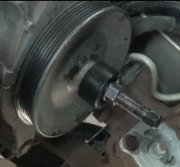Worn ball joints are pretty common on these vehicles. They can allow the tires to tilt a little which might lead to a barely noticeable pull, but they're more likely to cause tire wear and an inability to maintain alignment settings. Your alignment mechanic should have performed an inspection before doing an alignment. Another vote against ball joints, ... If you look at the steering arms / outer tie rod ends and the lower ball joints, you'll see they're in the same plane, (same height from the ground). As a result, any sideways movement in the upper ball joints will not move the steering arm in relation to the lower ball joint, so they won't cause a change in the steering wheel position or the direction the tires are steering.
Even though you replaced the steeing gear box, double-check it's adjustment. With the engine running, have a helper turn the steering wheel back and forth about six inches, twice per second. Watch were the pitman shaft comes out the bottom. If you see the shaft move sideways a little, then start to turn, it is either out of adjustment or the lower bushing is worn. 1/16" sideways movement is a real lot and will eventually lead to the shaft moving away from the seal and it will leak fluid. Also watch the input shaft for moving in and out like it's on a screw thread. It will move out and bottom out against the cover before it finally starts to turn. That cover is adjustable to eliminate the free play.
Any play in the collapsible two piece steering shaft will be felt as a knocking sensation long before it causes steering wander. Be sure the steering wheel comes back to center by itself after turning while you're moving. If it stays in the direction you last turned, the "memory steer" can mimic loose steering.
Worn idler arms are very common on GM vehicles. Glad you replaced it. They will allow the right tire to move left and right. Double-check that it is at the correct angle. Both ends of the centerlink must be at the same height from the ground. Loosen and adjust the idler arm to match the pitman arm. Of course, don't overlook play in the ball and socket of the pitman arm. That won't affect tire wear or any alignment angles, but it won't be fun to drive if it's sloppy.
As a last possibility, look at the caster numbers on the alignment printout. Caster can be increased to give more road feel, slightly harder steering, and better directional stability. Caster has no affect on tire wear except for when the tires are turned fully in either direction. Increasing caster will never be noticeable as far as tire wear is concerned. The reason for putting power steering on vehicles is to overcome the hard steering high positive caster causes. In return, the higher the caster value, (within reason), the more directional stability you will have.
Caradiodoc
Saturday, February 27th, 2010 AT 6:46 PM


